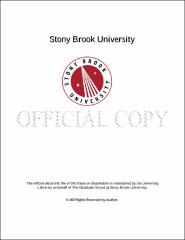| dc.identifier.uri | http://hdl.handle.net/11401/78375 | |
| dc.description.sponsorship | This work is sponsored by the Stony Brook University Graduate School in compliance with the requirements for completion of degree | en_US |
| dc.format | Monograph | |
| dc.format.medium | Electronic Resource | en_US |
| dc.format.mimetype | Application/PDF | en_US |
| dc.language.iso | en_US | |
| dc.type | Dissertation | |
| dcterms.abstract | This thesis focus on the modeling and forecasting financial durations by the Markov-Switching Multifractal Duration (MSMD) model with using ultra-high-frequency (UHF) data. We first review the literatures of both of autoregressive conditional duration (ACD) models and MSMD models, and point out the limitations of applying these models in the analysis of UHF data. We then study the facts of inter-trade, price and volume durations from the NASDAQ TotalView-ITCH database for US stocks, which consists of high precision transaction time stamp. We reveal a discovery of spike and diurnal periodic pattern in intra-day durations and introduce a new procedure for the adjustment of periodicity. We discuss the properties of MSMD model and show that the model is capable of generating high persistence and long memory series. We assume that innovations follow exponential, gamma, Weibull, Burr or generalized gamma distributions and propose an improvement for the Gam-MSMD process. The new process captures dynamics of both of the shape and scale parameters in gamma distribution. We perform Maximum-Likelihood Estimation for the MSMD models. The empirical evidence we present here is in conformance with the theoretical properties of the model, and both gamma and Weibull are shown to better fit the data than the exponential in certain aspects. The estimation and simulation results show that higher number of the Markov components does not necessarily bring better performance. Finally, we compare the out-of-sample forecasting performance of the ACD and MSMD models based on inter-trade, price and volume durations of four major equities (MSFT, INTC, FB and QCOM) traded on NASDAQ, and conclude that the MSMD models outperform ACD models. The Gamma and Weibull innovations are superior to the exponential in all types of durations. The complex distributions, Burr and generalized gamma, could not provide any improvements on fitting or forecasting. We also show that the modified Gam-MSMD process performs better in terms of capturing the variance of sequence. | |
| dcterms.available | 2018-07-09T14:43:00Z | |
| dcterms.contributor | Chen, Xinyun | en_US |
| dcterms.contributor | Glimm, James | en_US |
| dcterms.contributor | Rachev, Svetlozar | en_US |
| dcterms.contributor | Kim, Young Shin. | en_US |
| dcterms.contributor | Jiang, Danling. | en_US |
| dcterms.creator | Yang, Jianzhao | |
| dcterms.dateAccepted | 2018-07-09T14:43:00Z | |
| dcterms.dateSubmitted | 2018-07-09T14:43:00Z | |
| dcterms.description | Department of Applied Mathematics and Statistics. | en_US |
| dcterms.extent | 121 pg. | en_US |
| dcterms.format | Monograph | |
| dcterms.identifier | http://hdl.handle.net/11401/78375 | |
| dcterms.identifier | Yang_grad.sunysb_0771E_13391.pdf | en_US |
| dcterms.issued | 2017-08-01 | |
| dcterms.language | en_US | |
| dcterms.provenance | Submitted by Jason Torre (fjason.torre@stonybrook.edu) on 2018-07-09T14:43:00Z
No. of bitstreams: 1
Yang_grad.sunysb_0771E_13391.pdf: 4830653 bytes, checksum: 4ae355a3033549c52bbdb0c99511ddc7 (MD5) | en |
| dcterms.provenance | Made available in DSpace on 2018-07-09T14:43:00Z (GMT). No. of bitstreams: 1
Yang_grad.sunysb_0771E_13391.pdf: 4830653 bytes, checksum: 4ae355a3033549c52bbdb0c99511ddc7 (MD5)
Previous issue date: 2017-08-01 | en |
| dcterms.subject | Applied mathematics | |
| dcterms.subject | Financial durations | |
| dcterms.subject | Statistics | |
| dcterms.subject | Long memory | |
| dcterms.subject | Market microstructure | |
| dcterms.subject | Markov-switching model | |
| dcterms.subject | Multifractal model | |
| dcterms.subject | Ultra-high-frequency data | |
| dcterms.title | Modeling Financial Durations in Ultra-High-Frequency Data: A Markov-Switching Multifractal Approach | |
| dcterms.type | Dissertation | |

